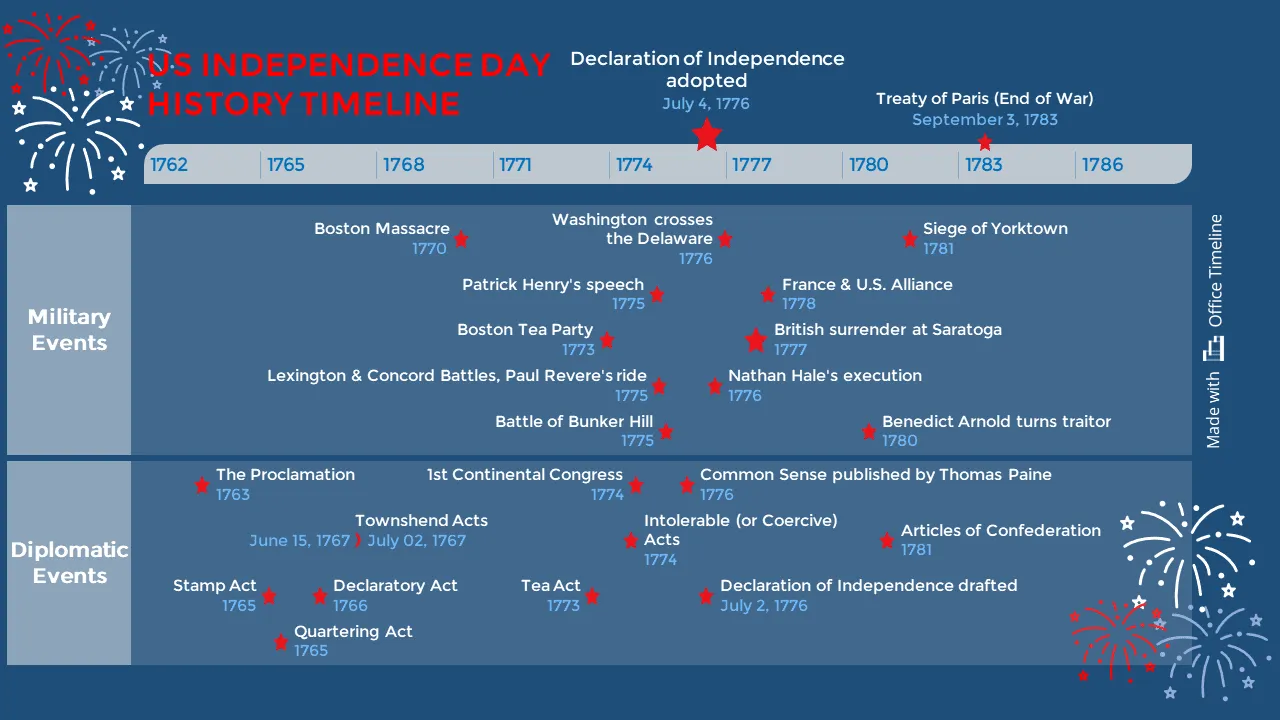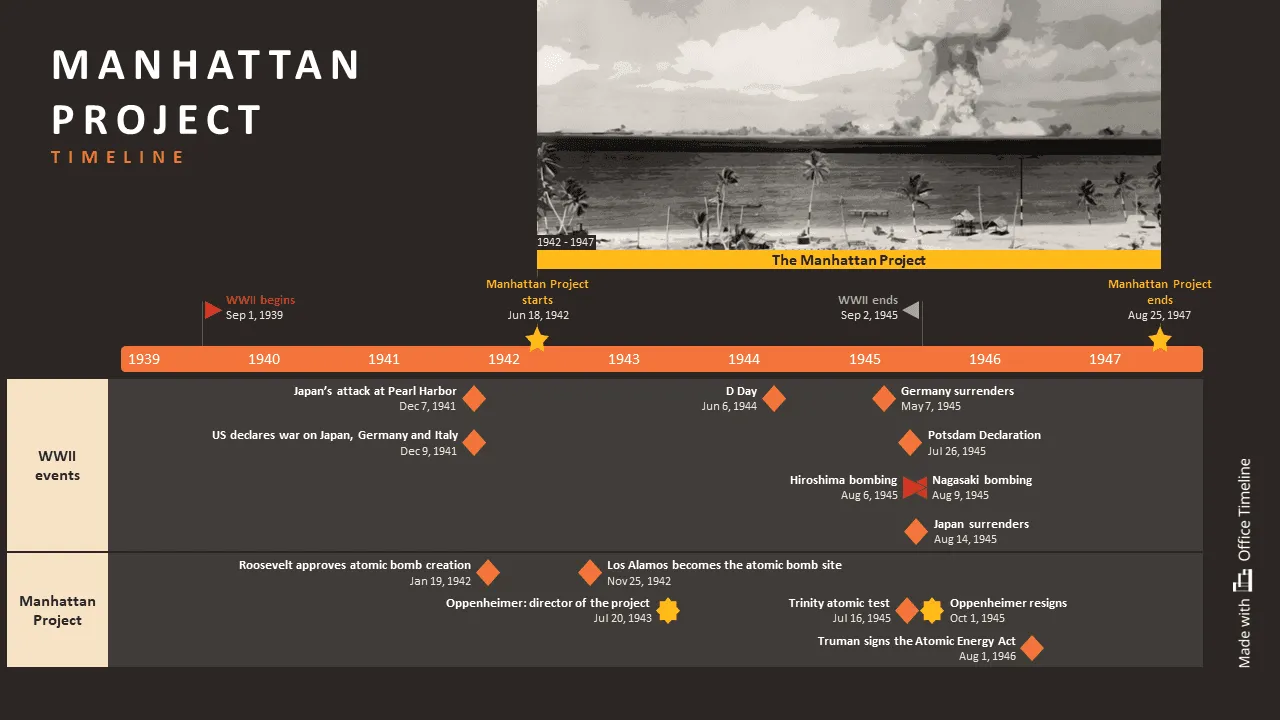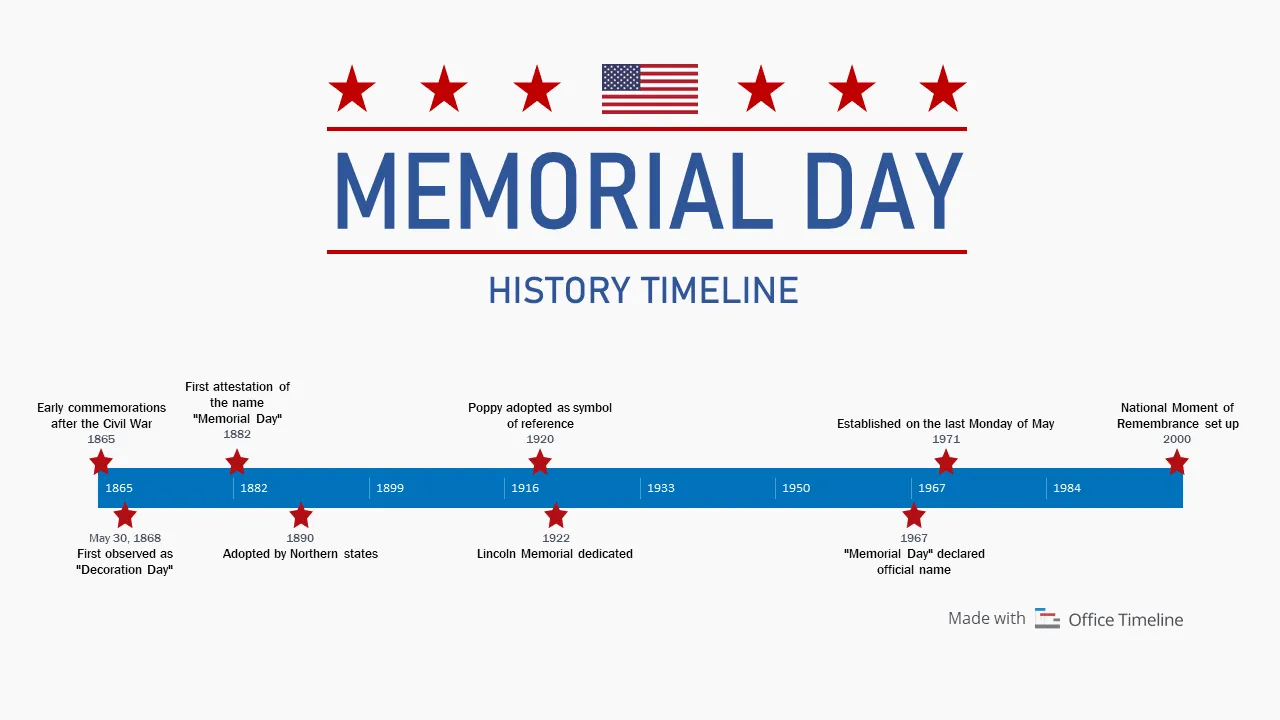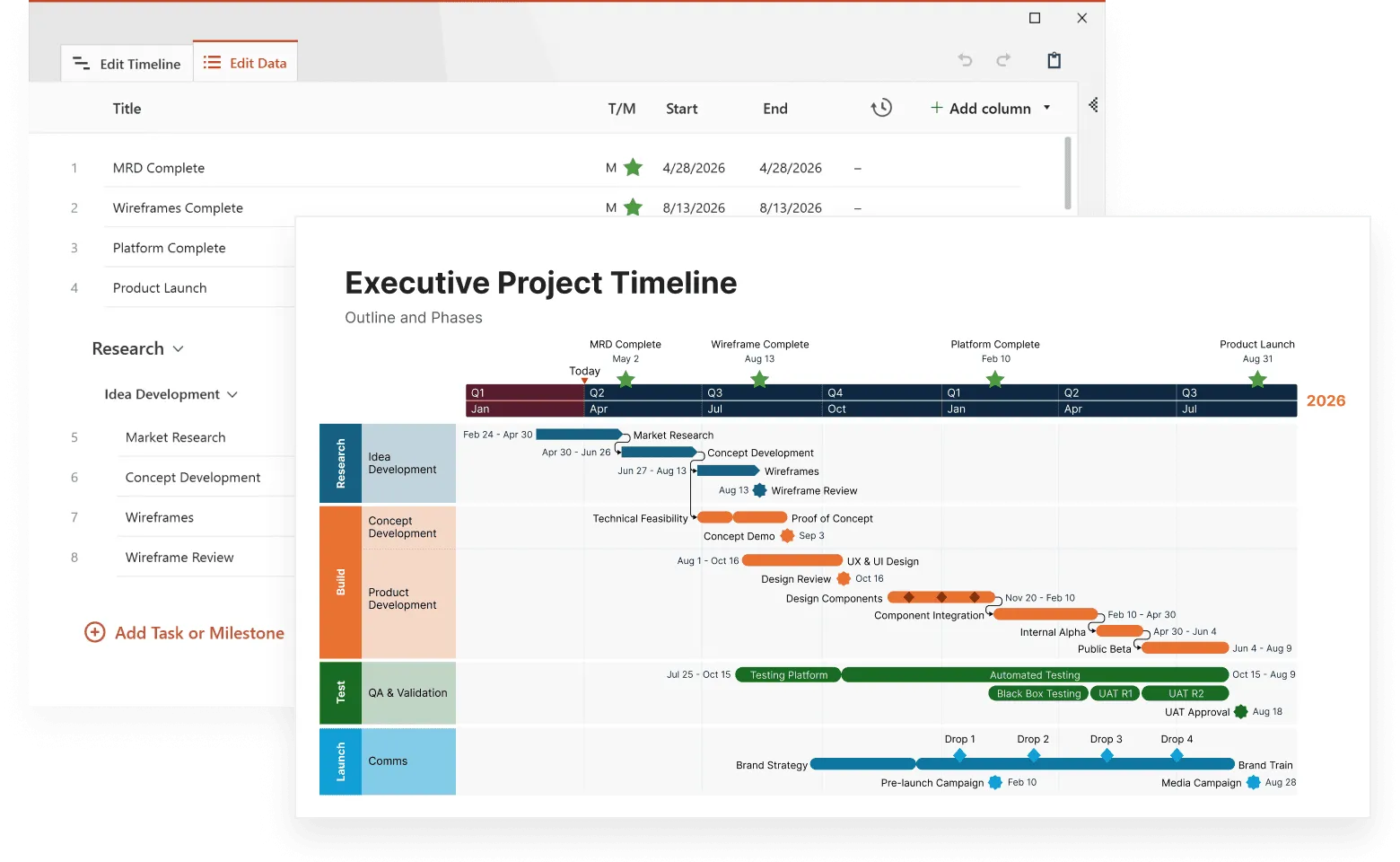History can be a labyrinth: names, dates, and events scattered across centuries, often with no clear path connecting them. Timelines are the maps we use to find our way through.
A historical timeline takes complex narratives and turns them into something visual and easy to follow. Instead of wading through dense paragraphs trying to remember what happened when, you see events laid out in order along a line. Suddenly, the connections become obvious.
You can trace how one moment influenced the next, spot patterns you'd otherwise miss, and grasp the flow of time in a way that traditional storytelling often hides.
This article explores how timelines simplify history. This does not mean oversimplifying, but by giving you a structure that makes complex events easier to understand. Think of it as turning chaos into clarity, one date at a time.
If you’d like to see how historical timelines compare to other types, check out our overview of types of timelines.
What makes timelines work
A historical timeline is a visual tool that shows you cause and effect at a glance.
Take this US Independence Day timeline. When you see events laid out in sequence, the pattern jumps out: the Stamp Act leads to colonial pushback, which leads to the Boston Massacre, which fuels the Tea Party, which triggers the Intolerable Acts. Each action provoked a reaction, and the escalation becomes obvious in a way it never is when you're just reading a textbook.
What makes this timeline especially useful is the split view. Military events run along the top, diplomatic milestones along the bottom. You can see that the Declaration of Independence was signed in July 1776, but the war had already been raging for over a year. France didn't join as an ally until 1778. These aren't just trivia facts; they explain why independence took seven years to achieve.
The visual structure gives you the "why" behind the history, not just the "what."
How structure shapes understanding
That split-view approach is just one way to organize historical information. The structure you choose determines what insights you'll gain.
Linear timelines run horizontally or vertically in strict chronological order - perfect when you need to see the straightforward progression of events, like tracking a single war or a monarch's reign.
Comparative timelines align parallel tracks of events happening in different places or contexts. This is what makes the US Independence timeline so effective: you see how battlefield developments and political negotiations unfolded side by side, each influencing the other.
Thematic timelines zoom in on specific subjects (technological breakthroughs, artistic movements, or medical discoveries) giving you depth rather than breadth.
The spacing matters too. When events are positioned according to their actual temporal distance, you instantly see which moments happened in rapid succession versus which were separated by years. Three months between the Boston Tea Party and the Intolerable Acts feels very different from the three years between Lexington and the Treaty of Paris. That rhythm tells its own story.
Seeing the bigger picture: history across borders
Consider the 15th century. While Constantinople fell to the Ottomans in 1453 (pushing Europeans to seek new trade routes), the Aztec Empire was expanding in Mesoamerica and China's Ming Dynasty was sending Admiral Zheng He's fleets across the Indian Ocean. These civilizations had no idea the others existed, yet their parallel developments would eventually collide and reshape the world.
Put these moments side by side and the connections become visible. When you see that the European Renaissance coincided with the Mughal Empire's golden age in India and the Songhai Empire's height in West Africa, you realize history isn't a single story, but many stories unfolding simultaneously. An innovation like papermaking or gunpowder could take centuries to travel the Silk Road, transforming every society it touched along the way.
A good timeline resists the temptation to treat any single region as the center of the story. It shows you the whole stage, not just one actor.
Practical applications of historical timelines
What can you do with historical timelines? If you're studying history, teaching a class, or just curious about how events connect, timelines help show the story behind the dates. They turn a list of events into something you can see and understand better. Here are some ways people use these visual tools:
Education
Teachers use historical timelines to help students grasp complex historical periods. For example, a middle school teacher might create a timeline of Ancient Egypt showing how the Old, Middle, and New Kingdoms developed over thousands of years, with specific pharaohs, monuments, and cultural developments marked along the way. This visual representation helps students see connections between events and understand the longevity of Egyptian civilization.
Research
Historians and researchers use timelines to identify patterns and gaps in historical records. A researcher studying the Industrial Revolution might create a detailed timeline showing technological innovations, policy changes, population movements, and economic indicators. This chronological arrangement could reveal correlations between specific policies and subsequent economic developments that might not be obvious when studying these factors in isolation.
Museums and public history
Museums create historical timelines to orient visitors to exhibitions. The National World War II Museum in New Orleans uses a massive timeline that spans multiple galleries to help visitors understand the progression of the war across different theaters. This chronological framework provides context for the artifacts, photographs, and personal stories featured throughout the museum.
Publishing and media
Authors, journalists, and documentary filmmakers use timelines to structure historical narratives. Ken Burns' documentary series "The Civil War" follows a chronological structure that helps viewers understand how the conflict evolved from its political origins through major battles to its resolution and aftermath.
Timeline examples that bring history to life
Want to see what makes a timeline really work? Let's look at some real-world examples that do a great job of telling complex stories. These timelines take confusing historical events with lots of moving parts and turn them into clear visual stories. Each one shows a different approach to organizing history, from world-changing scientific projects to national holidays and cutting-edge technology. Here are some standouts worth checking out:
The Manhattan Project timeline in WWII context
This timeline reveals surprising connections you might have missed in history class. For instance, while Allied forces were storming the beaches on D-Day in June 1944, Los Alamos had already been operating as the secret atomic bomb site for over a year and a half. You can see how Roosevelt greenlit the project in September 1939, just days after Germany invaded Poland, and track how the Trinity test in July 1945 happened just weeks before the war's end.
What makes this timeline valuable is seeing the compressed timeline: from Oppenheimer taking charge in 1942 to the bombs dropping on Hiroshima and Nagasaki in August 1945, the entire operational phase took less than three years. It puts the incredible scientific and logistical achievement (and its devastating conclusion) into stark perspective.
Memorial Day: from local tradition to national holiday
This timeline answers questions most people have never thought to ask. Did you know Memorial Day wasn't always called Memorial Day? It started as "Decoration Day" in 1868, when communities would decorate soldiers' graves with flowers. Northern states gradually adopted it, but it took nearly a century (until 1967) for "Memorial Day" to become the official name.
The timeline also shows meaningful details like when the red poppy became a symbol of remembrance (1918, inspired by WWI) and when the National Moment of Remembrance was established in 2000 (that 3 p.m. pause many observe). The shift to the last Monday in May came in 1971, creating the long weekend we know today.
These timelines were built with Office Timeline, a professional timeline maker for PowerPoint, which takes the headache out of organizing historical events. Instead of drowning in dates and trying to remember what happened when, you get a clear visual story that shows cause and effect, reveals patterns, and makes history actually stick in your memory.
Creating your own historical timeline
Creating an effective historical timeline requires thoughtful planning and execution. Here are some practical tips:
- Define your scope clearly: Decide on the time period and geographical area you want to cover, and determine what level of detail is appropriate for your purpose. A timeline covering the entire Roman Empire will need to be more selective about which events to include than one focusing only on the reign of Augustus.
- Research thoroughly: Consult multiple sources to verify dates and events. Academic journals, reputable history books, museum archives, and university websites are good starting points. For example, when creating a timeline of the French Revolution, you might cross-reference dates from the Oxford History of the French Revolution with primary sources like the Declaration of the Rights of Man.
- Select significant events: Not every historical occurrence deserves a place on your timeline. Choose events that had substantial impact or that illustrate important developments or trends. For a Civil Rights Movement timeline, you would include Brown v. Board of Education and the March on Washington, but might omit smaller local protests unless they had particular significance.
- Organize information logically: Group related events when possible, and use consistent formatting for similar types of information. If you're creating a timeline of scientific discoveries, you might color-code different fields like physics, biology, and chemistry to help viewers see patterns across disciplines.
Several tools and resources can assist in timeline creation:
- specialized timeline software offers customizable templates for different historical periods;
- library databases like JSTOR and Project MUSE provide access to scholarly historical resources;
- national archives and museum collections often have digitized primary sources;
- historical atlases and encyclopedias can provide verified chronological information.
Visual clarity is a necessary condition in timeline design. Use a clean, readable font and ensure adequate spacing between events. Consider using color coding to distinguish between different types of events (political, cultural, scientific, etc.). If including images, make sure they enhance understanding rather than distract from the information.
Create your historical timeline easily
Try Office Timeline for free. Use simple, ready-made templates to turn events into clear, beautifully structured timeline visuals.
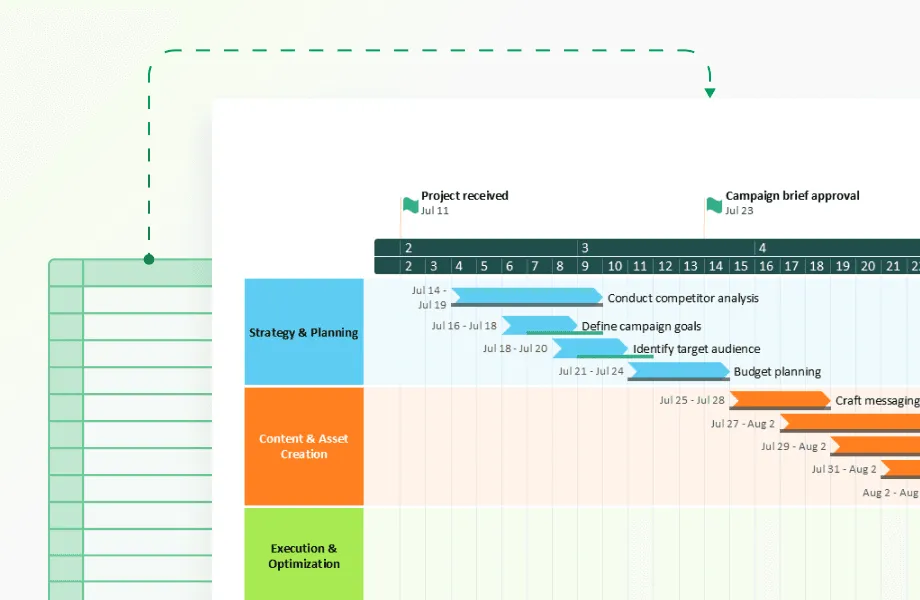
Common challenges in creating historical timelines
Creating a good timeline isn't as simple as it looks. When you try to map out history, you'll run into some tricky problems that everyone faces. From figuring out exactly when something happened (especially with events from long ago) to deciding which events deserve a spot on your timeline, these challenges can trip up even experienced historians. Here are some of the most common roadblocks you'll face and how to overcome them:
Dealing with uncertain dates
Historical records aren't always precise. For ancient history particularly, dates might be approximate or contested. A timeline of Ancient Mesopotamia might need to indicate date ranges rather than specific years, or use notation like "c. 3500 BCE" (circa 3500 BCE) to indicate approximate dates.
Solution: Use visual cues like dotted lines or color coding to show uncertainty, and include brief notes explaining major disagreements about dating.
Balancing detail with clarity
Including too many events makes a timeline cluttered and difficult to read, while including too few might miss important context. A timeline of the Cold War needs to be selective, including the Cuban Missile Crisis but perhaps omitting minor diplomatic meetings, while still providing enough information to show the evolution of superpower relations.
Solution: Create multiple layers or zoom levels that allow viewers to see both the big picture and drill down into details when needed.
Representing different perspectives
Historical events often look different depending on whose perspective is centered. A timeline of European colonization in the Americas should acknowledge both European and Indigenous perspectives on key events, perhaps by including parallel tracks showing how the same events were experienced by different groups.
Solution: Use multiple parallel tracks with color coding to show different perspectives, and include quotes or brief accounts from various viewpoints.
Avoiding oversimplification
Timelines can sometimes make historical developments seem more linear and inevitable than they actually were. A timeline of the Chinese Civil War should indicate the complexity of the conflict, perhaps by including notes on alternative paths that might have been taken at key junctures.
Solution: Add brief "what if" scenarios at key decision points, or include branching elements that show possible alternative outcomes that were considered at the time.
Conclusion: history made visible
Historical timelines turn history from just a bunch of dates and facts into something you can actually see and understand. They lay out events in order, showing how one thing led to another and helping us spot patterns that shaped our world.
These timelines aren't just for schools and teachers. Students use them to make sense of complex events, researchers spot gaps they might want to study further, writers and filmmakers use them to structure their stories, and anyone curious about history can use them to better understand the past.
Why not try making your own timeline? Whether it's about your family history, how your town developed, or a topic you're interested in, a timeline helps you organize what happened in a way that makes sense. Creating one connects you directly with history and helps you see how past events continue to shape our lives today.
Frequently asked questions
Here are answers to common questions about historical timelines to help you better understand their purpose and value in studying the past.
A historical timeline is a visual representation that shows events in order along a line, making relationships between events easy to see at a glance. A chronology is simply a list of events in time order, without necessarily having the visual element that makes timelines so effective for understanding history's flow
It depends on your purpose. For an overview of a long period like a century, include only major events. For a focused study of a shorter timeframe (like a war or revolution), you can include more detail. The key is to include enough events to show patterns without overwhelming viewers with too much information.
Yes. Digital timeline tools allow for interactive features like zooming in on specific periods, adding multimedia content (images, video, audio), and creating connections between related events. These features can make historical relationships clearer and more engaging than traditional paper timelines.


